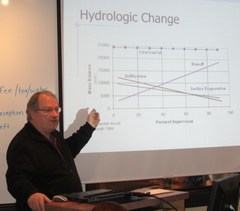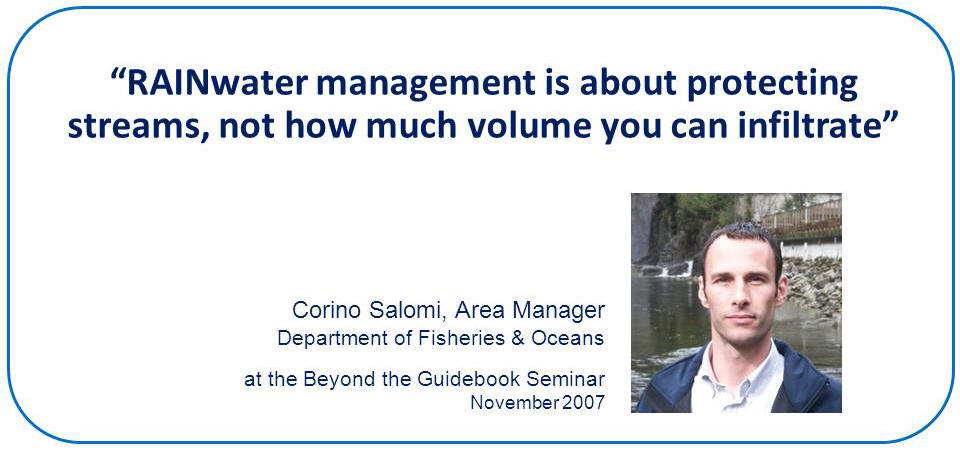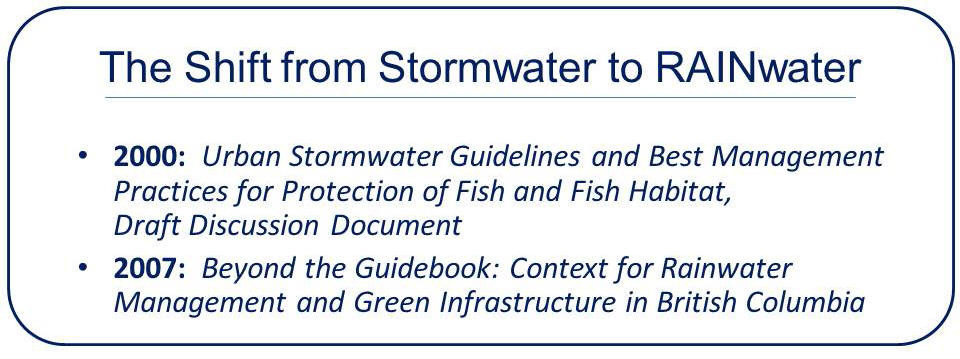FLASHBACK TO 2007: DFO’s Draft Urban Stormwater Guidelines Discussion Document (released in 2000) was a stepping stone to “Water Balance Methodology for Protecting Stream Health”
Note to Readers:
The following story comprises two parts. First, the “DFO Urban Stormwater Guidelines” are introduced. When released in 2000, these set a direction for protection of stream health. In part two, the Water Balance Methodology for protecting stream health is explained.
The Water Balance Methodology provided the technical foundation for Stormwater Planning: A Guidebook for British Columbia, released by the Province in 2002.
Application of the Water Balance Methodology enables development of watershed-based performance targets that mimic hydrologic function and maintain the natural Water Balance.
The Water Balance Methodology has been evolving as science-based knowledge and understanding have expanded and become clearer over time. This ongoing process is branded as the “Beyond the Guidebook” initiative, in part because it is adding depth to the 2002 Guidebook.
DFO’s “Urban Stormwater Guidelines” Set a Direction in 2000
“We are moving from guidelines to tools,” stated Corino Salomi in 2010 when he reflected on the evolution of the Water Balance Methodology and a science-based approach to rainwater management. Corino Salomi is Area Manager, Oceans, Habitat & Enhancement Branch, Lower Fraser Area. His area of responsibility extends from Mount Currie in the Pemberton Valley to Boston Bar in the Fraser River Canyon. This allows him to see the big picture in terms of region-wide action on the ground.
Stream Health Protection
“It helps to look back to understand how we got to here. In November 2000, DFO released the 4-page Urban Stormwater Guidelines and Best Management Practices for Protection of Fish and Fish Habitat, Draft Discussion Document,” continued Corino Salomi. “That document set a direction. It got practitioners thinking about how to capture rainfall in order to reduce runoff volume and protect water quality.”
“By 2007, however, we had concerns about how the document was being interpreted and applied. Beyond the Guidebook 2007 represented the initial course correction. It introduced a science-based analytical methodology that enabled local governments to explore the requirements for stream health protection.“
Beyond the Guidebook
“The purpose of the ‘Beyond the Guidebook’ initiative is to help local governments and the development community establish what level of rainwater runoff volume reduction makes sense at the site, catchment and watershed scales. The objective is to protect stream health, which is broader than how much volume one can infiltrate on a particular development,” stated Corino Salomi at the seminar in November 2007 which formally launched the Beyond the Guidebook initiative.
“Embracing the ‘Beyond the Guidebook’ philosophy means we will collaborate to improve land development practices because we share an ethic to do what is right for the environment. ”
“Drainage practice is at a crossroad in the path defining the methodologies and applications used in rainwater management. Beyond the Guidebook makes a clear distinction between a rainfall-based approach and a runoff-based approach.”
“While we need to have volume reduction targets, at the end of the day it is how effectively we apply the suite of available rainwater management tools that will ultimately determine whether we will succeed in protecting stream health at a watershed scale,” concluded Corino Salomi in his presentation on the Federal Fisheries perspective.
To Learn More:
To read a comprehensive story posted on waterbucket.ca in 2010, click on Application of the “DFO Urban Stormwater Guidelines” has evolved over the past decade to protect stream health
To download a copy of the 2000 document, click on Urban Stormwater Guidelines and Best Management Practices for Protection of Fish and Fish Habitat, Draft Discussion Document.
For additional historical context, click on Moving from Stormwater Management to RAINwater Management: A Federal Fisheries Perspective. This document summarizes the presentation by Corino Salomi at the Beyond the Guidebook Seminar held in November 2007.
Water Balance Methodology & Performance Targets
“A decade ago, looking at rainfall differently led the Province to initiate a change in the way rainwater is managed. In 2002, introduction of the Water Balance Methodology was a catalyst to trigger actions on the ground that would maintain or restore the natural Water Balance. The initial priority was to reduce surface runoff volume,” states Peter Law, Chair of the Guidebook Steering Committee and a  founding Director of the Partnership for Water Sustainability in British Columbia.
founding Director of the Partnership for Water Sustainability in British Columbia.
“Then, in 2007, the Beyond the Guidebook initiative enhanced the Water Balance Methodology to address the relationships between volume of rainwater captured and held on site, release to interflow, and resulting flow rates in streams.”
“By 2012, Beyond the Guidebook had also addressed the relationship between volume of rainwater captured and groundwater recharge. Application of the Water Balance Methodology enables local governments to establish a set of three watershed-specific and integrated Performance Targets.”
“Since 2012, the focus of the Beyond the Guidebook initiative has been on how to integrate and implement performance targets that result in balanced solutions. The key to mimicking the hydrology of a natural watershed is to replicate the shallow soil storage and conveyance system.”
Demonstrate Effectiveness of Mitigation Measures
“The water balance of a watershed is complex. There are three pathways by which rainwater reaches streams: surface runoff, interflow in shallow soils, and deep groundwater, ” continues Jim Dumont, the Partnership’s Engineering Applications Authority.
“The water balance of a watershed is a topic which has suffered from descriptions that oversimplify the processes to such an extent that unintentional adverse consequences may be occurring as a result of application of commonly employed prescriptive practices.  A goal of the Partnership in evolving the Water Balance Methodology is to address and rectify this issue of concern.”
A goal of the Partnership in evolving the Water Balance Methodology is to address and rectify this issue of concern.”
“Surface runoff is a small component of natural watershed function. The key to replicating watershed function and mitigating impacts is understanding ALL flow paths through the landscape. Then, Watershed-based Targets can be distilled into a set of design values that are easily applied at a lot level.”
“An integrated design for land development, rainwater management and groundwater recharge would balance the annual volume necessary for interflow storage with the annual volumes necessary to sustain the duration of interflow and allow infiltration to groundwater.”
“The Water Balance Methodology provides a logical and straightforward way to assess potential impacts resulting from urban development; and analytically demonstrate the effectiveness of the methods proposed for preventing and/or mitigating those impacts.”
“The Primer on the Water Balance Methodology lays the foundation for the integration of watershed information into a system of analysis that allows a practitioner to describe how the streams in a watershed are impacted by urban development.”
To Learn More:
Released in February 2014 by the Partnership, the Primer on Water Balance Methodology for Protecting Watershed Health is primarily written for a technical audience, and provides the water resource practitioner with how-to-guidance for applying an analytical process to establish the three Watershed-based Targets that “mimic the Natural Water Balance”.
In April 2014, the Partnership released a supplementary guidance document titled “An Introduction to the Water Balance Methodology for Protecting Watershed Health”.
A graphic representation of the application of the three targets can be envisioned in the graphic below of a typical rain garden. Note how the three watershed targets can be readily identified in the different parts of this standard installation.

How Performance Targets for Storage, Infiltration and Flow Release are incorporated in a Rain Garden Design (image source: “Stormwater Source Control Design Guidelines 2012 , Metro Vancouver, British Columbia)



